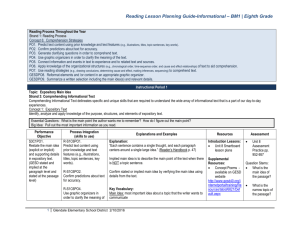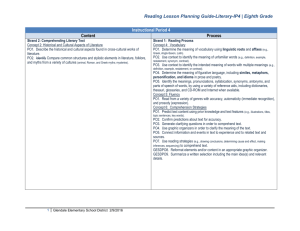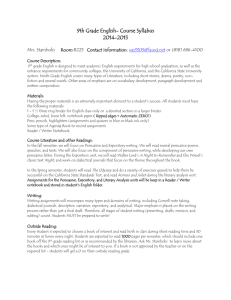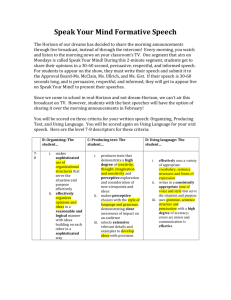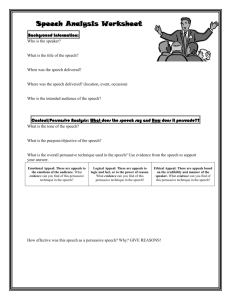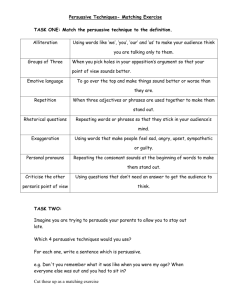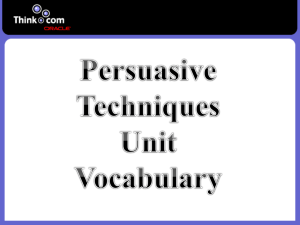Japan`s Nuclear Fears - Glendale Elementary School District
advertisement
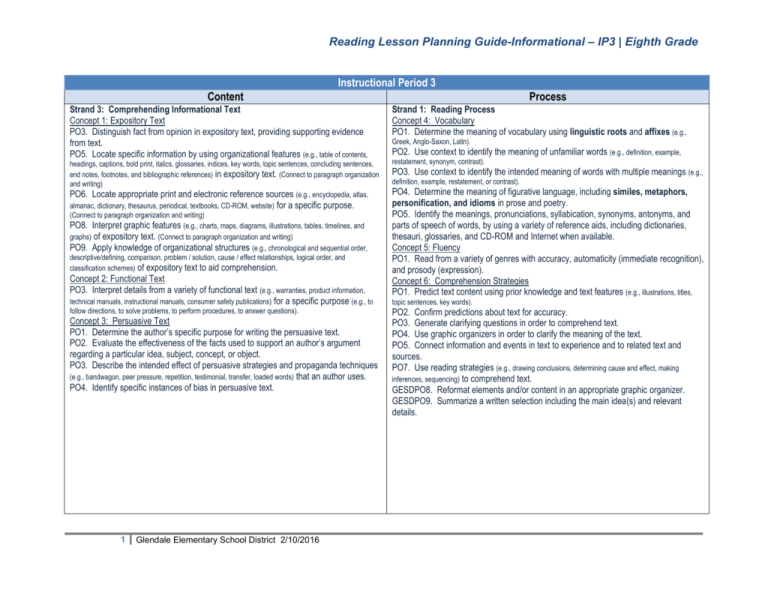
Reading Lesson Planning Guide-Informational – IP3 | Eighth Grade Instructional Period 3 Content Strand 3: Comprehending Informational Text Concept 1: Expository Text PO3. Distinguish fact from opinion in expository text, providing supporting evidence from text. PO5. Locate specific information by using organizational features (e.g., table of contents, headings, captions, bold print, italics, glossaries, indices, key words, topic sentences, concluding sentences, end notes, footnotes, and bibliographic references) in expository text. (Connect to paragraph organization and writing) PO6. Locate appropriate print and electronic reference sources (e.g., encyclopedia, atlas, almanac, dictionary, thesaurus, periodical, textbooks, CD-ROM, website) for a specific purpose. (Connect to paragraph organization and writing) PO8. Interpret graphic features (e.g., charts, maps, diagrams, illustrations, tables, timelines, and graphs) of expository text. (Connect to paragraph organization and writing) PO9. Apply knowledge of organizational structures (e.g., chronological and sequential order, descriptive/defining, comparison, problem / solution, cause / effect relationships, logical order, and classification schemes) of expository text to aid comprehension. Concept 2: Functional Text PO3. Interpret details from a variety of functional text (e.g., warranties, product information, technical manuals, instructional manuals, consumer safety publications) for a specific purpose (e.g., to follow directions, to solve problems, to perform procedures, to answer questions). Concept 3: Persuasive Text PO1. Determine the author’s specific purpose for writing the persuasive text. PO2. Evaluate the effectiveness of the facts used to support an author’s argument regarding a particular idea, subject, concept, or object. PO3. Describe the intended effect of persuasive strategies and propaganda techniques (e.g., bandwagon, peer pressure, repetition, testimonial, transfer, loaded words) that an author uses. PO4. Identify specific instances of bias in persuasive text. 1 Glendale Elementary School District 2/10/2016 Process Strand 1: Reading Process Concept 4: Vocabulary PO1. Determine the meaning of vocabulary using linguistic roots and affixes (e.g., Greek, Anglo-Saxon, Latin). PO2. Use context to identify the meaning of unfamiliar words (e.g., definition, example, restatement, synonym, contrast). PO3. Use context to identify the intended meaning of words with multiple meanings (e.g., definition, example, restatement, or contrast). PO4. Determine the meaning of figurative language, including similes, metaphors, personification, and idioms in prose and poetry. PO5. Identify the meanings, pronunciations, syllabication, synonyms, antonyms, and parts of speech of words, by using a variety of reference aids, including dictionaries, thesauri, glossaries, and CD-ROM and Internet when available. Concept 5: Fluency PO1. Read from a variety of genres with accuracy, automaticity (immediate recognition), and prosody (expression). Concept 6: Comprehension Strategies PO1. Predict text content using prior knowledge and text features (e.g., illustrations, titles, topic sentences, key words). PO2. Confirm predictions about text for accuracy. PO3. Generate clarifying questions in order to comprehend text. PO4. Use graphic organizers in order to clarify the meaning of the text. PO5. Connect information and events in text to experience and to related text and sources. PO7. Use reading strategies (e.g., drawing conclusions, determining cause and effect, making inferences, sequencing) to comprehend text. GESDPO8. Reformat elements and/or content in an appropriate graphic organizer. GESDPO9. Summarize a written selection including the main idea(s) and relevant details. Reading Lesson Planning Guide-Informational – IP3 | Eighth Grade Reading Process Throughout the Year Strand 1: Reading Process Concept 6: Comprehension Strategies PO1. Predict text content using prior knowledge and text features (e.g., illustrations, titles, topic sentences, key words). PO2. Confirm predictions about text for accuracy. PO3. Generate clarifying questions in order to comprehend text. PO4. Use graphic organizers in order to clarify the meaning of the text. PO5. Connect information and events in text to experience and to related text and sources. PO6. Apply knowledge of the organizational structures (e.g., chronological order, time-sequence order, and cause and effect relationships) of text to aid comprehension. PO7. Use reading strategies (e.g., drawing conclusions, determining cause and effect, making inferences, sequencing) to comprehend text. GESDPO8. Reformat elements and /or content in an appropriate graphic organizer. GESDPO9. Summarize a written selection including the main idea(s) and relevant details. Instructional Period 3 Topic: Persuasive Text Strand 3: Comprehending Informational Text Comprehending Informational Text delineates specific and unique skills that are required to understand the wide array of informational text that is a part of our day-to-day experiences. Concept 3: Persuasive Text Explain basic elements of argument in text and their relationship to the author's purpose and use of persuasive strategies. Essential Questions: What is the author’s purpose? How is the author convincing the reader? What does the author use? What’s the purpose for this selection? Big Idea: Author’s use techniques to convince readers. Performance Objective S3C3PO1. Determine the author’s specific purpose for writing the persuasive text. Process Integration (skills to use) R-S1C6PO3. Generate clarifying questions in order to comprehend text. R-S1C6PO5. Connect information and events in text to experience and to related text and sources. R-S1C6PO7. Use reading strategies to comprehend text. 2 Explanations and Examples Explanation: Find out what the author is trying to attempt to prove or convince the reader’s view point. When reading persuasive writing look for the view point statement. Key Vocabulary: (see also S3C3PO3 key vocabulary) To persuade: the act of swaying others’ feelings, beliefs, or actions Viewpoint statement: the author’s perspective or opinion on issue or topic Author’s Purpose (Persuasive): To convince the reader of their viewpoint Glendale Elementary School District 2/10/2016 Resources Introduction Lessons: Reader’s Handbook Lesson Plan Book, pages 247-249 Reader’s Handbook Student Applications, page 107-08 (step 1) McDougal Littell’s Standard Lesson Files, Lesson 7, Proposition- Assessment Unit 9 Test A, Questions 1, 3, and 11 Unit 9 Test B/C, Questions 1,3, and 11 Reading Lesson Planning Guide-Informational – IP3 | Eighth Grade Author’s perspective: (a more nuanced form of view point) Is the unique combination of opinions, values, feeling and beliefs that influences the way the writer looks at a topic, tone or attitude often reviles the author’s perspective. Tone: The expression of the attitude a writer takes toward a subject. For example: humorous, shocked, bitter, scornful As the PO addresses persuasive text in general, the author’s general purpose will be “to persuade”. The PO pushes students beyond this to consider the nuances of the author’s argument, word choice, and perspectives. Support, pages 239-245 Supplemental Resources: In McDougall Littell, “Robo-Legs” pages 928-937 McDougall Littell Resource Manager, pages 127-146 Example: After reading paragraph, work with students to recognize strong language about author’s sympathy for poor farmers. Examples: “low prices”, “extreme poverty”, armed gangs of white ruffians”. Organize thoughts in organizer. From Ida B. Wells by Dennis and Judith Fradin “The story of these twelve condemned men is a sad commentary on American society in the early 1900s. They and their families had been sharecroppers-farmers who were paid low prices for their crops and generally lived in extreme poverty. In Phillips County, Arkansas, along the Mississippi River, sharecroppers had tried to join together into a union to demand better prices for their cotton. Outraged by the idea for poor black farmers demanding anything, armed gangs of white ruffians from Arkansas, Tennessee, and Mississippi poured into Phillips County and murdered dozens of black sharecroppers.” 3 Glendale Elementary School District 2/10/2016 Reading Lesson Planning Guide-Informational – IP3 | Eighth Grade Provide a prompt—e.g.: Cell phones should be allowed in school. Groups brainstorm pros and cons in a t-chart. Students select 1 (pro/for or con/against) and write an opinion statement. S3C3PO2. Evaluate the effectiveness of the facts used to support an author’s argument regarding a particular idea, subject, concept, or object. R-S1C4PO3. Use context to identify the intended meaning of words with multiple meanings. R-S1C4PO4. Determine the meaning of figurative language, including similes, metaphors, personification, and idioms in prose and poetry. R-S1C6PO3. Generate clarifying questions in order to comprehend text. 4 Find editorials on the same “side” of an issue. Students locate and then compare the author’s opinion statements of the two editorials. Explanation: Evaluate the evidence or support the author uses to prove his/her position. For an argument to be effective, the viewpoint must be clear, convincing, and supported. Introduction Lessons: Reader’s Handbook, page 249-255 Key Vocabulary: (see S3C3PO3 key vocabulary also) Support: facts, figures, statistics, and examples used to support the author’s opinion statement. Reader’s Handbook Lesson Plan book, page 101 Opposing Viewpoint/Counter-Argument: the opposite claim or the objection to the writer’s claims McDougal Littel, Standards Lesson File— Lesson 13, pages 301-310; Lesson 14, pages Proposition or Claim: the writer’s position, problem, issue Glendale Elementary School District 2/10/2016 Assessment: Question Stems: Which of the following, if added to _____, would most likely persuade ____ to _____? OR Which of the author’s statements best persuades ____ to _____? McDougal Littel Assessment book, pages 1024-1027 Reading Lesson Planning Guide-Informational – IP3 | Eighth Grade R-S1C6PO7. Use reading strategies to comprehend text. Example: Introduce what makes a good argument (see Reader’s Handbook Lesson Plan book, page 101) Provide students with short piece of persuasive text. Students work in pairs to complete the argument chart. (See Reader’s Handbook, page 248-249) VIEWPOINT SUPPORT OPPOSING VIEWPOINT/ COUNTERARGUMENT 315-323; Lesson 16, pages 331-344; Lesson 17, pages 345-350 Supplemental Resources: Reader’s Handbook Student Applications book, pages 107-109, 110-112, and 97-106 McDougal Littel Student Literature Book, pages R25-R26 In partners, students are assigned to one of 3 groups. Each group gets a position to argue—Group A, Group B, Group C. Each pair is allowed 5 sentences to make their argument. The first sentence is the claim or position and then 4 supports. Claim/Position sentence (all of Group A should have the same position, etc) First supporting sentence Second supporting sentence Third supporting sentence Fourth supporting sentence S3C3PO3. Describe the intended effect of 5 R-S1C6PO3. Generate clarifying questions in order to comprehend text. One group at a time, the teacher (or alternate students) read the groups’ arguments aloud. Students rank these arguments and justify their answer. What made one better than another? Explanation: Describe and analyze the intended effect of persuasive strategies and propaganda techniques. Glendale Elementary School District 2/10/2016 Introduction Lessons: Standards Lesson File: Targeted TE pp. 10241029 Unit and Reading Lesson Planning Guide-Informational – IP3 | Eighth Grade persuasive strategies and propaganda techniques (e.g., bandwagon, peer pressure, repetition, testimonial, transfer, loaded words) that an author uses. R-S1C6PO7. Use reading strategies to comprehend text. R-S1C6PO5 Connect information and events in text to experience and to related text and sources. Key Vocabulary: Included but not limited to Appeal to Loyalty: relies on people’s affiliation with a particular group Plain Folks Appeal: common everyday people support it Bandwagon Appeal: appeal to the audience’s desire to be socially accepted Snob Appeal: the “best” people support it Appeal to Authority: appeal to the audience’s admiration of a specific expert or authority Testimonial: The product or service is recommended by a celebrity. Loaded Words: words that have strong emotional associationssuch as mother, family and patriotism-are used Glittering Generalities: advertisement includes vague words with positive connotation Transfer: The advertiser connects the product to something else that is pleasing. Repetition: say it often-slogan-jingle Peer Pressure: encouraging or forcing a person to change their attitude, values or behavior in order to conform to group norms Example: Model how to describe the intended effect of persuasive strategies and propaganda techniques. Distribute copies of a print advertisement, or play a clip for a television ad (MEDIA SMART) Read aloud or listen to the information presented in the ad, and identify the central claim or argument. Then identify any persuasive strategies and propaganda techniques used to support the claim. 6 Glendale Elementary School District 2/10/2016 Instruction for Arizona Standard p. 41 TE R20-R26 TE R92-R93 TE 1010-1023 Standards Lesson File: Reading and Informational Text pp. 321-330 Readers Handbook pp. 247264 Benchmark Tests - Unit 9, pp. 205-211 Reading Lesson Planning Guide-Informational – IP3 | Eighth Grade Answer the following questions to locate the techniques and strategies: Does the advertiser appeal to the audience’s desire to be socially accepted? (BANDWAGON APPEAL) Is the product or service recommended by a celebrity? (TESTIMONIAL) Does the advertiser connect the product to something else that is pleasing? (TRANSFER) Does the ad include vague words with positive connotations? (GLITTERING GENERALITIES) For each technique or strategy identified determine the intended effect. For example advertisers use bandwagon appeal because the belief that “everyone else” is using the product may persuade potential consumers to use it, too. Think aloud about the effectiveness of the techniques used for making an idea, a product, or a service appealing. S3C3PO4. Identify specific instances of bias in persuasive text. R-S1C4PO3. Use context to identify the intended meaning of words with multiple meanings. R-S1C4PO4. Determine the meaning of figurative language, including similes, metaphors, personification, and idioms in prose and poetry. R-S1C6PO3. Generate clarifying questions in order to comprehend text. R-S1C6PO7. Use reading strategies to comprehend text. 7 Explanation: Determine whether a persuasive text contain bias. Key Vocabulary: Bias: In a piece of writing, the author’s bias is the side of an issue that he or she favors. Words with extremely positive or negative connotations are often a signal of an author’s bias. Credibility: the believability or trustworthiness of a source and the information it provides Evidence: a specific piece of information that supports a claim Evidence can take the form of a fact, a quotation, an example, a statistic, or a personal experience, among other things Inductive Reasoning: process of logical reasoning that moves from observations, examples, of facts to broad generalizations Deductive Reasoning: process of logical reasoning that begins with a general premise and advances with evidence to a specific conclusion Glendale Elementary School District 2/10/2016 Introduction Lessons: Standard Lessons File: Targeted Instruction for Arizona Standards p. 42 McDougal Littel, Standard Lesson File, lesson 15, pages 329-333— teaching the techniques allows students to identify techniques, quantity and nature of techniques aid in identifying author’s bias Assessment: Question Stem: The author demonstrates bias through which of the following statements? Reading Lesson Planning Guide-Informational – IP3 | Eighth Grade Example: Adaptation of Lesson from Emily Tymus in Wisconsin Supplemental Resources: For homework the night before, students on a piece of paper, write down (in their opinion) the two best sources of news. Also right down their criteria for “quality” news source. Have each student meet with a partner to share their lists from last night. Together, as a class, make two giant lists that will stay on the wall for the duration of the unit; one list is entitled “Our Picks for Best News Sources,” the second is called “What Makes Quality News?” then briefly coach students to watch a tape of last night’s BBC World News. Give them a table for recording information BBC World News CRITERIA Type of stories Length of stories Common graphics Indications of bias Reliability of source ?? Watch the BBC World News and complete the criteria chart as a class. Have several other news sources available (electronic, tv news, magazine, newspaper). In partners, students complete the other side of the criteria chart. Lead discussion about bias in evaluating new sources. How does this help us evaluate bias in individual pieces? 8 Glendale Elementary School District 2/10/2016 This website has many media resources. http://www.webenglishte acher.com/media.html# Reading Lesson Planning Guide-Informational – IP3 | Eighth Grade Topic: Text Organization Strand 3: Comprehending Informational Text Comprehending Informational Text delineates specific and unique skills that are required to understand the wide array of informational text that is a part of our day-to-day experiences. Concept 1: Expository Text Identify, analyze and apply knowledge of the purpose, structures, and elements of expository text. Essential Questions: What should I be thinking about when I'm reading? What clues indicate the organization of the text? Why did the author write this? Big Idea: Authors' structure expository text to accomplish their purpose. Performance Objective S3C1PO3. Distinguish fact from opinion in expository text, providing supporting evidence from text. Process Integration (skills to use) R-S1C4PO3. Use context to identify the intended meaning of words with multiple meanings. R-S1C6PO3. Generate clarifying questions in order to comprehend text. R-S1C6PO7. Use reading strategies to comprehend text. R-S1C6PO4 Use graphic organizers in order to clarify the meaning of the text. Explanations and Examples Resources Assessment Explanation: Recognize the difference between a statement that is a fact and a statement that is an opinion in a piece of expository text and need to evaluate the facts and opinion. When evaluating a fact look at the source of the information, when reading opinions they need to be well supported by facts, experiences, and accounts of experts and other accounts of reliable sources. Introduction Lesson: Standards Lesson File Reading Lesson 5 Distinguishing Fact from Opinion Unit 8 Test A, p. 169, questions 1, 11, 13, & 15, Facts: Opinion: Can this statement be proven? Clues- dates, names, statistics Is the statement a thought or feeling Would the statement always be true? Clues- feel, believe, worst, always, best, never, most, never, least Key Vocabulary: Fact: A statement that can be proven. Opinion: A statement of someone’s personal belief. Supplemental Resources: ML Text Interview with a SongCatcher pp. 908-917 Should Wildlife Stay Wild? pp. 968-969 Zoos – Myth and Reality pp. 970973 Zoos Connect Us To the Natural World pp. 974-979 Evidence: the proof from text Example: Write criteria for fact and opinion in one column each. 9 Glendale Elementary School District 2/10/2016 Reader’s Handbook p. 281 Question Stem: According to the passage, which statement is a fact? Reading Lesson Planning Guide-Informational – IP3 | Eighth Grade Fact: Can be proven Opinion: expressed belief by writer Write out three pairs of statements: This room is cold. The temperature in this room is 63 degrees. My teacher assigns too much homework. My teacher assigns one hour of reading nightly. Our lunch break seems short. Our lunch break is 30 minutes. Have student place each statement in correct column. Students will need to explain why they choose fact or opinion in complete sentences, for example “This is a fact because, this is an opinion…” Use Quick Read expository passages for distinguishing facts from opinions. S3C1PO5. Locate specific information by using organizational features (e.g., table of contents, headings, captions, bold print, italics, 10 R-S1C6PO1. Predict text content using prior knowledge and text features (e.g., illustrations, titles, topic sentences, key words). R-S1C6PO2. Confirm predictions about text for accuracy. R-S1C6PO3. Explanation: Understanding the organization, graphic features and elements of a textbook. Depth of PO: Find Feature, Explain Purpose, and use the information to Apply within text. -Works easily with persuasive textSpecific to: Title – topic/main idea at passage level Glendale Elementary School District 2/10/2016 McDougal Littell: Resources… Other Sources: Use the internet to pull more examples of organizational features. Question Stems: What is the purpose of… the title, topic sentence, etc.? What does a heading help me to understand? How do subheadings help to comprehend Reading Lesson Planning Guide-Informational – IP3 | Eighth Grade glossaries, indices, key/guide words, topic sentences, concluding sentences, end notes, footnotes, and bibliographic references) in expository text. (Connected to Research Strand in Writing) Generate clarifying questions in order to comprehend text. R-S1C6PO4. Use graphic organizers in order to clarify the meaning of the text. R-S1C6PO5. Connect information and events in text to experience and to related text and sources. R-S1C6PO6. Apply knowledge of the organizational structures. Headings – topic at paragraph level sub-headings – relevant details topic sentences – main idea/thesis statement concluding sentences – main idea/thesis statement Key Vocabulary: See BM 1 for vocabulary if needed Example 1: Use What’s the Source – pp. 904-905. Any other text with organizational features could be used. BEFORE students read they add text features to their graphic organizer. While reading students will add information they have learned to match to the text features. Structure your graphic organizer based on the organizational features within the text. Graphic Organizer (can copy and paste into SMART notebook): Example 2: 11 Glendale Elementary School District 2/10/2016 Use mail, school newsletter, or flyers to pull features. Pull text with features from the library or bookroom. Using Science and Social Studies textbooks for features text? Sentence Frames: A title tells me ___________. The topic sentence for ________ is ___________. The difference between headings and sub-headings is ______________ _________. I use _________ for________. A _________ helped me to locate information for _____________. Reading Lesson Planning Guide-Informational – IP3 | Eighth Grade The headings and titles in print go from broadest to narrowest. The purpose of headings and titles is to create an order, from the broadest topic to the narrowest topic. One way to incorporate this standard is to use the above graphic organizer with social studies and science content. Students can reformat graphic features. 12 Glendale Elementary School District 2/10/2016 Reading Lesson Planning Guide-Informational – IP3 | Eighth Grade S3C1PO6. Locate appropriate print and electronic reference sources (e.g., encyclopedia, atlas, almanac, dictionary, thesaurus, periodical, textbooks, CDROM, website) for a specific purpose. (Connected to Research Strand in Writing) R-S1C6PO1. Predict text content using prior knowledge and text features (e.g., illustrations, titles, topic sentences, key words). R-S1C6PO2. Confirm predictions about text for accuracy. R-S1C6PO4. Use graphic organizers in order to clarify the meaning of the text. R-S1C6PO5. Connect information and events in text to experience and to related text and sources. Explanation: Students will find both print and electronic sources for a purpose. McDougal Littell Anthology Reader’s Workshop - pp. 1034-1051 Reader’s Handbook pp. 515-535 Reader’s Handbook Student Application Book pp. 185-192 Key Vocabulary: Continue defining and categorizing vocabulary from instructional period 1. Example: Use a graphic organizer with specific author’s purposes on one side of the organizer and as a class, discuss which print or electronic reference the student would use to achieve purpose. Enter a website on http://www.resourcelinks.net/coolkids.htm Read and examine the personal website and ask these questions: What do you think is useful here? What errors or problems do you see? What is the purpose of this site? Using a 9-column sorting mat labeled with sources, students sort questions/statements written on cards to determine appropriate source. For example: “If I want to find a synonym for a word, but not the definition, which source would I use?” This question would be placed in the Thesaurus column. 13 Glendale Elementary School District 2/10/2016 Internet: Use the internet to pull more examples of electronic reference sources Possible Online sources: www.mapquest.co m www.maps.google .com www.farmersalma nac.com www.dictionary.co m www.britannica.co m Question Stems: From which key word search would you most likely find this website… You would find the best example of this topic in… The most reliable source for this topic would be found… How does your knowledge of these sources help you as a reader? Reading Lesson Planning Guide-Informational – IP3 | Eighth Grade S3C1PO8. Interpret graphic features (e.g., charts, maps, diagrams, illustrations, tables, timelines, and graphs) of expository text. (Connected to Research Strand in Writing) R-S1C4PO3. Use context to identify the intended meaning of words with multiple meaning (e.g., definition, example, restatement, synonym, contrast). R-S1C6PO3. Generate clarifying questions in order to comprehend text. R-S1C6PO5. Connect information and events in text to experience and to related text and sources. R-S1C6PO6. Apply knowledge of the organizational structure (e.g. chronological order, time sequence order, and cause and effect relationships) of text to aid comprehension. R-S1C6PO7. Use reading strategies (e.g. drawing conclusions, determining cause and effect, making inferences, sequencing) to comprehend text. 14 Explanation: Graphic aids such as photographs, charts, diagrams and maps, illustrations, tables, timelines, captions are visual tools that allow readers to see important details at a glance. Reading a Graphic Preview Checklist: The title Any captions or background Any labels The column and row headings The key or legend The scale or unit of measurement The source Reader’s Handbook (pp. 539) Reader’s Handbook p.165 Question Stems: According to the map, which of these countries boarders__________? According to the bar graph, which month did ______________? Using the timeline above, which of the following happened before the ______? ** Refer back to S3C1PO5 - Text Features and Graphic Aids are taught separately but should be integrated** What type is the graph above? Key Vocabulary: Refer back to BM1 if vocabulary is needed When would you use a circle graph? Example: Connect information from graphic features within persuasive text in order to determine persuasive techniques and/or bias. When would you use a timeline? 1. Students interpret illustrations to determine persuasive techniques within advertisements. Glendale Elementary School District 2/10/2016 Reading Lesson Planning Guide-Informational – IP3 | Eighth Grade Title of Illustration Persuasive techniques used and examples Summary of information My thoughts and connections 2. Students then look for other examples in text. S3C1PO9. Apply knowledge of organizational structures (e.g., chronological order, comparison, problem / solution, cause /effect relationships, logical order, and classification schemes) of expository text to aid comprehension. R-S1C6PO4. Use graphic organizers in order to clarify the meaning of the text. R-S1C6GESDPO8. Reformat elements and /or content in an appropriate graphic organizer. Explanation: Identify the organization of an expository piece. Use knowledge of this organization type to find information. Begin to compare/contrast different types of organization and what information is in each piece of text. Make sure to vary length of passages to show the variation in text organization. **Use previously used organizational structures in this BM to compare/contrast to cause and effect relationships** Key Vocabulary: *See previous vocabulary if needed* Cause and Effect: an event and its consequences Example: Read the article from TIMES for KIDS Reformat text using a cause effect graphic organizer Write a summary March 16, 2011 Japan's Nuclear Fears More trouble takes hold of the Asian nation after a strong quake and powerful waves caused deadly destruction last week 15 Glendale Elementary School District 2/10/2016 Standards Lesson file Cause and Effect p.201 Interactive ReaderStrategic Steps to Teach Cause and Effect R6 Reader’s Handbook Cause and Effect p. 275 Organizational Structure of Paragraphs p.5563 ML Text Cause and Effect R10 Standards Lesson File Cause and Effect p.203 Unit 9 Test A Questions 10,12,16,17,22 Test B/C Questions 7,9,17 Reading Lesson Planning Guide-Informational – IP3 | Eighth Grade BY JONATHAN ROSENBLOOM AND KELLI PLASKET The effects of the massive earthquake and tsunami that struck Japan last Friday are still playing out at Japan's nuclear power plants. Nuclear reactors at Japan's Fukushima Daiichi nuclear plant are experiencing cooling problems after the tsunami waves knocked out the plant's power and backup power. On Monday morning, an explosion occurred at the Fukushima Daiichi plant that blew off the roof of one of the buildings. Some radiation— KYODO NEWS/AP energy that can be People with empty jugs walk through a damaged harmful at high levels— neighborhood in Kesennuma, Japan, in search of fresh water. Water and food supplies are low has been released into following Friday's massive earthquake and tsunami. the air as efforts continue to shut down the reactors. Two of the three reactors that were operating when the quake struck have since been damaged. Cooling problems at the reactors have led to nuclear fuel overheating and fires, causing fears of a meltdown at the plant. Now, 50 workers are working around the clock to flood the reactors with seawater to cool off the fuel rods. Fears of radiation exposure in Japan are slowing down recovery efforts from the tsunami. Some 70,000 residents have been 16 Glendale Elementary School District 2/10/2016 Reading Lesson Planning Guide-Informational – IP3 | Eighth Grade evacuated from the 12-mile area around the plant. Another 140,000 people in a 19-mile area have been told to stay indoors. Many outside of the area are heading south, just to be safe. Radiation exposure testing centers have been set up for residents, but authorities believe that most people have not been exposed to high levels of radiation. A Rippling Effect The massive earthquake that struck Japan last Friday registered a 9.0 magnitude—upgraded from an original 8.9-magnitude reading by the U.S. Geological Survey. It was the most powerful temblor to hit Japan since officials there began keeping records 140 years ago. Before this, the country's worst earthquake was an 8.3 temblor in 1923. Japan lies on the "Ring of Fire"--an area rimming the Pacific Ocean. About 90 percent of the world's earthquakes take place in that region. With the updated 9.0 reading, Friday's quake ranks as the fourth largest quake in the world since 1900, scientists say. The center of the quake was located about 17 miles beneath the ocean floor, in a spot 80 miles off the eastern coast of the island nation. "The earthquake has caused major damage in a broad area in northern Japan," Prime Minister Naoto Kan said. This week, millions of people are still without water, food or heat as recovery efforts continued and as new problems arose at the nation's nuclear power plants. 17 Glendale Elementary School District 2/10/2016 Reading Lesson Planning Guide-Informational – IP3 | Eighth Grade Dozens of cities and villages along a 1,300-mile Residents of Kesennuma in northern Japan, walk stretch of along a road with the ruins of the town behind coastline them were shaken by violent tremors Friday. Because it struck below the Pacific Ocean, the quake set off waves as high as a three-story building. The monstrous waves, called a tsunami (soo-nah-mee), swept away homes, boats and cars as the water roared several miles inland, stopped, and rolled back out to sea. Highways buckled, telephone lines snapped, and fires broke out. Hundreds of aftershocks, or smaller quakes, have followed the big quake, causing more damage and forcing residents to seek safety outside. TSUYOSHI MATSUMOTO—THE YOMIURI SHIMBUN/AP Tokyo, Japan's capital, is about 230 miles away from the center of the quake (Click here to see a map of Japan). But even there, people felt the ground shake. Buildings swayed, at least 2 million homes were without electricity, and trains stopped running. "At first it didn't feel unusual, but then it went on and on. So I got myself and my wife under the table," said Jesse Johnson, an American living in Tokyo. "I've lived in Japan for 10 years and I've never felt anything like this before. The aftershocks keep coming. It's gotten to the point where I don't know whether it's me shaking or an earthquake." Japan's Devastation The total damage, deaths and injuries won't become clear for days or even weeks. On Wednesday, Japanese officials reported that the death toll has reached more than 3,600, though thousands remain missing. "In the 65 years after the end of World War II, this is the toughest and the most difficult crisis for Japan," Prime Minister Kan said. A large-scale emergency response operation continues in northern Japan. As of Monday, about 15,000 people have been 18 Glendale Elementary School District 2/10/2016 Reading Lesson Planning Guide-Informational – IP3 | Eighth Grade rescued. A 60-year-old Japanese man floated on a piece of his house's roof for over two days. He was rescued 10 miles offshore Sunday when sailors spotted the man waving a red flag. Many of the world's nations have offered to assist Japan. President Obama has ordered five Navy ships to head for the island to help, as well as search and rescue teams. Secretary of State Hillary Clinton is closely watching the situation. She promised immediate disaster relief assistance. "We are working closely with the government of Japan to provide additional help," she said in a statement. As the damage becomes clearer, Japan may need all the help it can get. 19 Glendale Elementary School District 2/10/2016 Reading Lesson Planning Guide-Informational – IP3 | Eighth Grade Topic: Functional Text Strand 3: Comprehending Informational Text Comprehending Informational Text delineates specific and unique skills that are required to understand the wide array of informational text that is a part of our day-to-day experiences. Concept 2: Functional Text Identify, analyze, and apply knowledge of the purpose, structures, clarity, and relevancy of functional text. Essential Questions: What is functional text? How does organization and clarity aid in the comprehension of functional text? How does the reader solve problems and draw conclusions from functional text? When reading functional text, why is it critical to analyze the information and interpret details? Big Idea: The reader interprets details for specific purposes. I will be able to find information from many sources to solve a problem and draw conclusions. Performance Objective S3C2PO3. Interpret details from a variety of functional text (e.g., warranties, product information, technical manuals, instructional manuals, consumer safety publications) for a specific purpose (e.g., to follow directions, to solve problems, to perform procedures, to answer questions). Process Integration (skills to use) R-S1C6PO6 Apply knowledge of the organizational structure (e.g. chronological order, time sequence order, and cause and effect relationship) of text to aid comprehension R-S1C6PO3. Generate clarifying questions in order to comprehend text. R-S1C6PO7. Use reading strategies to comprehend text. R-S1C6PO5 Connect information and events in text to experience and to related text and sources. Explanations and Examples Resources Assessment Explanation: Students identify a specific purpose for reading the text. Read, understand, and organize details in this text to achieve this purpose. Introduction Lessons: McDougal Little, Standard Lesson File—lessons 1820, pages 351-381 Key Vocabulary: Functional Text: text with everyday information (This includes workplace documents, recipes, manuals, registration forms. Sometimes works can be both persuasive and functional—for example, a registration form for a local karate class.) Question Stems: Which information is not necessary to know before entering the contest? Supplemental Resources: McDougal Littel Student Literature Book, pages R16R19—give samples of functional text. Details: important information that supports the main idea. If the details are not important, they should be considered extraneous. Purpose for Reading: This is the reason we read. Functional text purposes will generally fall into one of four categories—Reading to: follow directions, gain information, fill out forms, use references. Author’s Purpose: This is why the author writes a text. This is often integrally related to the reader’s purpose for reading. Warranty: This is a guarantee on a product or service. Manual: This is a text which gives instructions on how to do 20 Glendale Elementary School District 2/10/2016 Which of the following details are important to _________? If you want to ____, what would you do _____? Reading Lesson Planning Guide-Informational – IP3 | Eighth Grade something. Product Label: This is text typically found on the outside of a product which give details about its content. Form: A form is an organized structure for information. Often a form is a collection device for demographic or personal information. Application: A form submitted to request inclusion or consideration. Example: Teacher sets up various scenarios. If I wanted to take a test, what would I need? Directions If I wanted to bake cookies, what would I need? Recipe If I wanted to program my cell phone, what would I need? Instruction Manual If I wanted to register to play soccer, what would I need? Registration Form Students sort functional text into categories—“Reading to Follow Directions”, “Reading to Gain Information”, “Reading to Fill Out Forms”, “Reading to Use References”. (This can also be done as an open sort with students developing the categories themselves.) Give specific instruction on which details are relevant to achieving these different reading purposes. Allow students to refine their sorts. Students should justify their sorting rationale. (This can later be turned into work stations.) Students would answer questions pertaining to the specific purpose involved with their reading type. Students complete graphic organizer for a piece of functional text. My Purpose for Reading: Which details from this text will help me achieve/meet my purpose? Author’s Purpose for Writing: 21 Glendale Elementary School District 2/10/2016

